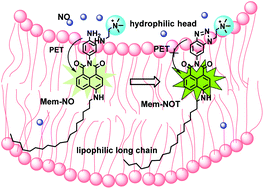Targetable, two-photon fluorescent probes for local nitric oxide capture in the plasma membranes of live cells and brain tissues†
Abstract
Although the plasma membrane is a major site for nitric oxide (NO) generation and action, few targetable probes that specifically sense and image NO in the plasma membrane have been reported. In this study, a membrane targetable, two-photon nitric oxide probe, Mem-NO, was developed and evaluated for bio-imaging of both exogenous and endogenous NO. By installing a quaternary ammonium compound as the hydrophilic head and a long alkyl chain as the hydrophobic tail on 4-amino-1,8-naphthalimide, we designed Mem-NO into a bi-polar structure. Due to the interaction with the phospholipid bilayer of plasma membrane, Mem-NO could specifically and stably localize in the plasma membrane. Mem-NO is almost nonfluorescent, but it displayed substantial fluorescence enhancement (16-fold) upon NO capture with sensitive (74 nM limit of detection) and fast response (within 1 min). Moreover, Mem-NO displayed strong two-photon excitation fluorescence activity (δ = 177 GM at 810 nm) and low cytotoxicity. It was found that Mem-NO is capable of two-photon imaging of endogenous NO in live neurons and human umbilical vein endothelial cells (HUVECs) and exogenous NO in mouse brain tissues. Therefore, Mem-NO qualifies as an essential and unique analytical tool for monitoring NO for future physiological, pathological, and pharmacological studies.



 Please wait while we load your content...
Please wait while we load your content...